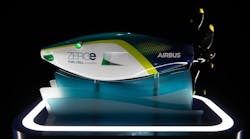NASHUA, N.H. - Rugged data storage for military and aerospace applications have evolved quickly from rotating to solid-state media, such that for all practical purposes, solid-state data storage is the defacto choice today for defense systems integrators.
It’s come to the stage that rotating storage media rarely even are mentioned as alternatives to secure data storage in the military. “Just about everything we are doing now is based on solid-state disk,” says Amos Deacon III, president of president of data storage expert Phoenix International Systems in Orange, Calif. The rare occasions where rotating media are considered options, systems designers must take the time and make the investment to designed specialized ruggedized packages, Deacon says.
So that leaves designers with options in solid-state storage media, and today that overwhelmingly means Non-Volatile Memory Express, better-known as NVMe. “The biggest technical trend in recent years is the transition to NVMe for storage in many, if not all cases,” says Dominic Perez, chief technology officer at the Curtiss-Wright Corp. Defense Solutions segment in Portland, Ore.
The biggest advantage of NVMe is pure speed, which for the vast majority of systems designers outweighs NVMe’s drawbacks in power consumption, thermal management, and ruggedization. NVMe’s speed is the biggest reason that it has surpassed in popularity other solid-state storage media such as Serial AT Attachment (SATA) and Serial Attached SCSI (SAS). SATA is a computer bus interface that connects host bus adapters to data storage devices like hard disk drives, optical drives, and solid-state drives.
“NVMe is six times faster than SATA and SAS,” says Curtiss-Wright’s Perez. “Solid-state drives were a revolution a decade ago when they were 10 times faster than a spinning disk, and now we are looking at nearly another order of magnitude speed improvement with NVMe.” Perez is involved with the Curtiss-Wright PacStar brand; Curtiss-Wright acquired Pacific Star Communications Inc. (PacStar) in Portland, Ore., last year.
The NVMe design approach enables data storage media such as solid-state drives to access processors via the PCI Express databus, rather than through relatively slow specialized data storage interfaces. It also enables host hardware and software to capitalize on levels of parallelism possible in modern solid-state drives. NVMe essentially connects data storage directly to system processors, and avoids throughput bottlenecks of data storage interfaces.
Increased read/write speeds
NVMe can increase data read and write speeds over SATA by four to five times — sometimes even more. As an example, SATA reaches its upper-speed limits at about 600 megabytes per second, while NVMe can sustain read and write performance of more than 3 to 3.5 gigabytes per second. One principle behind NVMe is switching from serial to parallel data interfaces to increase data throughput.
“The amount of data that these NVMe systems can suck in is incredible,” says Robin Wessel, executive vice president of solid-state storage provider DIGISTOR in Vancouver, Wash. “Driving NVMe is increased bandwidth. The speeds are significantly higher than the SATA-based solutions they replace.”
NVMe technology, furthermore, “can record several streams of video or other sensor data simultaneously without a hiccup,” Wessel says. “Industry is moving to NVMe as the standard, and away from architectures of the past like SATA.”
Aerospace and defense applications increasingly rely on speed and the ability to record multiple data streams simultaneously. “For I/O-intensive applications like artificial intelligence (AI) bringing in data from a lot of sensors, these NVMe devices will greatly speed-up workflows. The adoption curve is just starting for the military,” says Chris Kruell, director of marketing at DIGISTOR.
The PCI Express interface for NVMe is gaining widespread popularity in aerospace and defense applications. “We have shifted over to NVMe for our small-form-factor data recorders,” says Rodger Hosking, director of sales in the Mercury Systems Mixed Signal business (formerly Pentek) in Upper Saddle River, N.J. “It offers a more efficient interface because it is PCI Express. Also, it can accommodate SATA solid-state drives.”
NVMe data storage bypasses the SATA interface and goes directly to PCI Express to boost throughput speeds, Hosking explains. “We also can take advantage of the commercial trends to get numbers up and costs down.” Mercury Mixed Signal is shipping NVMe in a rugged rackmount server — even for some ruggedized airborne applications, Hosking says.
“We are using NVMe now in our 100-gigabit Ethernet data recorder, which records optical streams at rates of 12.8 gigabytes per second,” Hosking says. We are using multiple NVMe drives connected with an NVME RAID controlled plugged into a PCI Express controller board. We aggregate those four drives to get the speed that we need, and that is working quite well. We are chasing those two standards, PCI Express and NVMe, and as they evolve they will get faster, more rugged, and more reliable.”
In addition to its big advantages in speed, NVMe also is smaller than SATA and SAS, which lends itself to today’s demands for small size and light weight in aerospace and defense systems. NVMe solid-state drives are much smaller than SATA drives and weigh about four times less, which makes them suitable not only for laptop computers, but also for size- and weight-sensitive military applications. In addition, systems designers can attach NVMe memory components directly to motherboards and single-board computers, which also can cut down on size and weight.
Drawbacks of NVMe
Not everything about NVMe is an advantage for military and aerospace systems designers. Compared with its predecessors, SATA and SAS, NVMe is more expensive, more difficult to ruggedize, consumes more power, and can be a challenge to keep cool enough for maximum performance.
NVMe memory is not as inherently as rugged as SATA and SAS data storage, which can increase the challenge of packaging NVMe for mobile military applications that must operate in extreme temperatures, shock, and vibration.
“Compared to SATA and SAS, NVMe is immature when it comes to ruggedization,” says Eric Rucker, director of airborne systems at Mercury Systems in Torrance, Calif. (formerly Physical Optics Corp.). “We in Torrance are qualifying M2 and the U.2 format for NVMe, with much larger capacity and much larger drives.” While these kinds of data storage might be appropriate for forward-deployed military command posts, “a jet pulling nine Gs, we haven’t gotten there yet.” Mercury acquired Physical Optics last year.
Mercury has qualified a four-terabyte M2 NVMe drive, and is starting to do flight tests on some of the company’s military platforms that are in development, and may enter production on these systems by fall 2022.
As for NVMe M2 and U.2 drives, “those are not for rugged military applications yet,” says Mercury’s Hosking. We have to do the qualification ourselves. NVMe is quite mature for general-purpose commercial applications, but that extreme environmental performance is a thing we are struggling with.”
Finding the best way to ruggedize NVMe memory for military uses is a common challenge today. “A lot of NVMe comes off the same fabs,” says Curtiss-Wright’s Perez. “Our job is to find the best of the best and make sure it is rugged and reliable enough, and that it fits in the smallest possible space.”
Echoes Mercury’s Hosking: “We are doing a very specialized application that is very demanding, using the best commercial NVMe devices available to us. You take the best and fastest you can get, qualify it, and then try something a little different.”
Thermal management
Perhaps one of the most serious weaknesses of NVMe for rugged military applications is its ability to operate in cold and hot temperatures. The Curtiss-Wright TTC business unit in Newtown, Pa., specializes in onboard aircraft test and measurement, in which data storage media must be subjected to high levels of shock, vibration, and temperature extremes.
“We are looking at technology improvements even in NVMe,” says Sridhar Kanamaluru, chief architect for Curtiss-Wright TTC. “We know our test conditions are very harsh; solutions have to work from -40 to 85 degrees Celsius, and NVMe memories are pretty touchy. At times they do not work at these temperature levels, which imposes additional design constraints for us.”
Compounding the picture is the relatively high power consumption of NVMe vs SATA and SAS storage media. More power consumption means generating more waste heat, which forces designers either to design-in cooling, or throttle-down the speed of the data storage to keep within temperature constraints.
“Thermal management is a challenge; they use more power, so they impose a more stringent engineering design to support data capacities,” Kanamaluru says.
When it comes to cooling NVMe, he says there are several ways to do it. “There are mechanical and thermal-management techniques that we could use, such as heat pipes that would enable us to manage the localized heating, and enable us to bring the heat out of the memories and out of the chassis. Also can use thermal electric coolers.” In extreme cases, Kanamaluru says he and his designers can use some of the same kinds of thermal-management techniques that embedded computing manufacturers use to cool hot microprocessors — including liquid cooling.
Kanamaluru acknowledges that often it’s up to NVMe storage designers to design the right kinds of cooling for their systems. “If we had a choice of other technologies, with the right speeds, that operated at a higher temperature, then we would consider that and could use it,” he says. “Vendors we talk to are coming up with their own environmental solutions, and packaging them to enable cooling. We are testing all the NVMe memories that we are buying to shock and vibration profiles to see that they meet requirements.”
For many, however, the thermal-management tradeoffs of NVMe are worth making. “There are more concerns of NVMe around the thermals and cooling for these drives,” points out DIGISTOR’s Kruell. “People need to take this into account. We offer heat sinks for air transfer and heat exchange.”
Are SATA and SAS dead?
All the obvious design advantages of NVMe over its predecessors may have designers asking, are SATA and SAS data storage dead? The answer, definitely not.
“SATA, the previous generation of data storage technology, is still in wide use,” says DIGISTOR’s Wessel. “In SATA you don’t have to concern yourself as much with connections and signal integrity, yet with PCI Express and NVMe the margins are much less because signal integrity has to be maintained for those kinds of speeds. We will continue to offer SATA-based technologies for quite some time. A lot of the chips are still the same, but the controllers are different. If you want to get a SATA drive five years from now, you certainly can.”
The thermal performance of NVMe, at least for now, also may give systems designers a reason to take a second look at SATA and SAS. Experts point out that NVMe when it throttles-back its performance in particularly hot temperatures places its speeds near that of SATA and SAS. Given the lower costs of SATA and SAS, that might give designers something to think about.
“In a perfect enterprise world, one NVMe drive would give you 3,000 to 4,000 megabytes per second for a single drive, with Gen 4 PCI Express speeds,” says Phoenix’s Deacon. “But with higher temperatures, the drives basically go to Gen 3 speed, or 400 to 500 megabytes per second, instead of thousands of megabytes. At those speeds, SATA or SAS drives are much more competitive. SATA is 600 megabytes per second, with 500 megabytes sustained speed. Now all of a sudden, your SATA speeds are equal to NVMe speeds.”
SATA and SAS still have their adherents in the data storage industry. “We are still basically SAS- and SATA-centric as far as storage devices go that we integrate,” says Phoenix’s Deacon. “We are getting more and more into what they call edge storage applications. Our product line conforms with that nicely, in that we have traditionally made products that are modular, rugged, and have proven to be reliable in harsh environments.”



